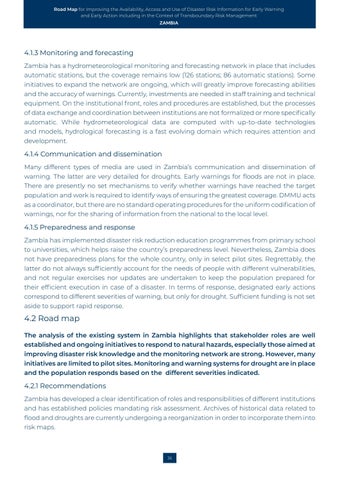Road Map for Improving the Availability, Access and Use of Disaster Risk Information for Early Warning and Early Action including in the Context of Transboundary Risk Management ZAMBIA
4.1.3 Monitoring and forecasting Zambia has a hydrometeorological monitoring and forecasting network in place that includes automatic stations, but the coverage remains low (126 stations; 86 automatic stations). Some initiatives to expand the network are ongoing, which will greatly improve forecasting abilities and the accuracy of warnings. Currently, investments are needed in staff training and technical equipment. On the institutional front, roles and procedures are established, but the processes of data exchange and coordination between institutions are not formalized or more specifically automatic. While hydrometeorological data are computed with up-to-date technologies and models, hydrological forecasting is a fast evolving domain which requires attention and development.
4.1.4 Communication and dissemination Many different types of media are used in Zambia’s communication and dissemination of warning. The latter are very detailed for droughts. Early warnings for floods are not in place. There are presently no set mechanisms to verify whether warnings have reached the target population and work is required to identify ways of ensuring the greatest coverage. DMMU acts as a coordinator, but there are no standard operating procedures for the uniform codification of warnings, nor for the sharing of information from the national to the local level.
4.1.5 Preparedness and response Zambia has implemented disaster risk reduction education programmes from primary school to universities, which helps raise the country’s preparedness level. Nevertheless, Zambia does not have preparedness plans for the whole country, only in select pilot sites. Regrettably, the latter do not always sufficiently account for the needs of people with different vulnerabilities, and not regular exercises nor updates are undertaken to keep the population prepared for their efficient execution in case of a disaster. In terms of response, designated early actions correspond to different severities of warning, but only for drought. Sufficient funding is not set aside to support rapid response.
4.2 Road map The analysis of the existing system in Zambia highlights that stakeholder roles are well established and ongoing initiatives to respond to natural hazards, especially those aimed at improving disaster risk knowledge and the monitoring network are strong. However, many initiatives are limited to pilot sites. Monitoring and warning systems for drought are in place and the population responds based on the different severities indicated.
4.2.1 Recommendations Zambia has developed a clear identification of roles and responsibilities of different institutions and has established policies mandating risk assessment. Archives of historical data related to flood and droughts are currently undergoing a reorganization in order to incorporate them into risk maps.
36



